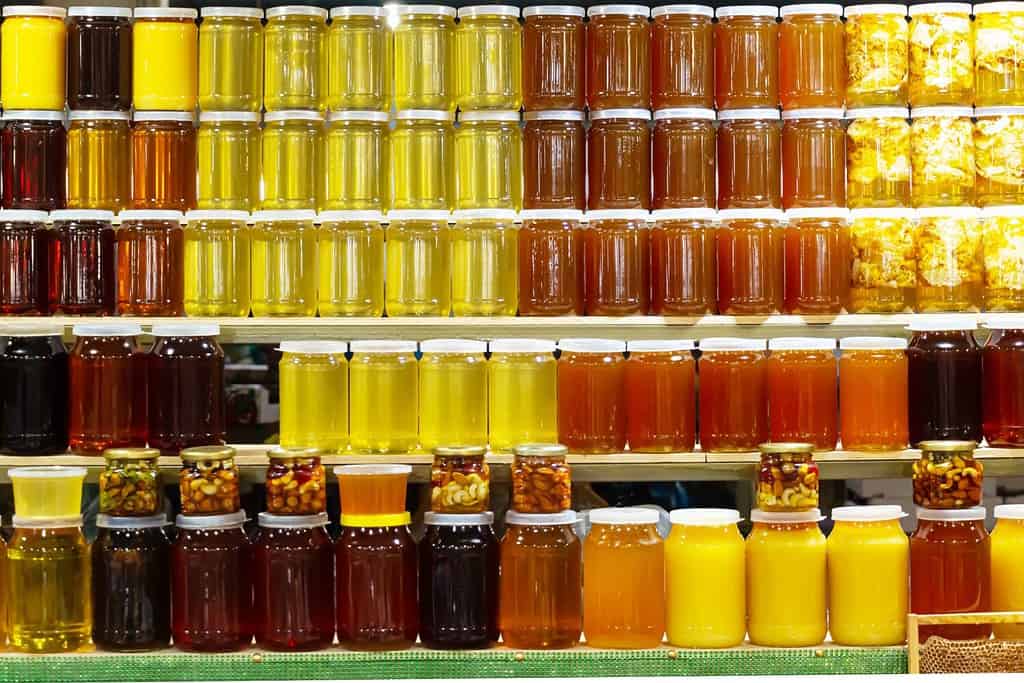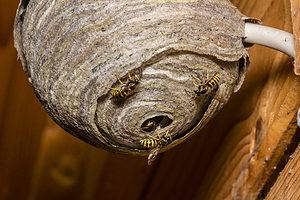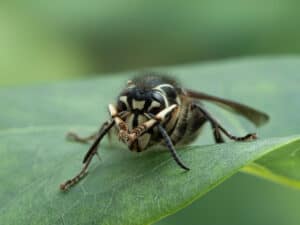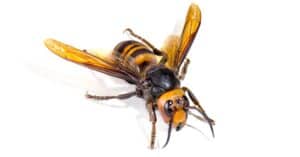Is a wasp more hostile or dangerous to humans than bees? Which one would win in a fight? Are people who are allergic to one also allergic to the other? How can you tell them apart?
These are all examples of common questions when comparing the two. Believe it or not, even experts have difficulty telling a wasp from a bee. Most bees are ground-dwelling as are all wasps, so there must be ways of physically distinguishing them without having to get too close. We’ll go into detail about their differences below!
The 7 Main Differences Between Wasps and Bees
Wasp vs Bee: Size
The biggest difference right off the bat is size. Bees are about a half-inch in length, while wasps are 3/4 inches in length.
Wasp vs Bee: Appearance
There are several unique markers to distinguish the two insects which are both of the order Hymenoptera. Both bees and wasps are brightly colored and may even have similar colors such as black with yellow. They also have 2 pairs of wings. However, bees and wasps are pretty much polar opposites when it comes to the shape of their bodies, although some bees resemble wasps at first sight. Bees have fat, hairy bodies, and wasps have thin, smooth ones. Bees have hairy, flat, and round legs instead of the smooth, round, and waxy legs of wasps. They also have a round abdomen and thorax, whereas those of wasps are cylindrical, known as thread-waisted or a wasp waist.
Wasp vs Bee: Habitat
Solitary bees live in a hole in the ground or in wood, but social and eusocial species such as honeybees and bumblebees create hexagonal wax hives containing honey. They can build their hives in rock crevices, hollow trees, on tree branches, inside the walls of a building, under the roof of a house, or in attics.
Wasps create papery nests of chewed-up wood pulp simply for the purpose of reproduction or for their colony. Their nests are in overhangs such as tree branches and under roofs, but ground-dwelling wasps build their nests in dry soil. Social wasps build nests in a variety of areas, whereas solitary wasps can be parasitic or predatory, but only the predatory ones build nests.
Wasp vs Bee: Aggressiveness
Bees aren’t normally aggressive. In the cases they are, it’s often because they are in a large colony, they lack a queen, or are irritated due to the weather. Wasps, on the other hand, are more aggressive and famous for being territorial as well as bigger and stronger.
One of the most aggressive wasp species is the yellow jacket. Their striped wasps will go after a victim and sting repeatedly even when they only get close to a nest. While honey bees are perceived to be neutral, there are some aggressive types of bees, like Africanized honey bees. The drones of these species will swarm by the thousands, leaving victims with hundreds of stings.
Wasp vs Bee: Feeding habits
Bees are pollinators. Wasps are predators, preying on animals to feed their young or parasitize them to lay eggs, but adult wasps are herbivorous and visit flowers for sugar, also acting as pollinators.
Wasp vs Bee: Sting
A bee’s sting is acidic. The honeybee dies after stinging once because its stinger is barbed, but other bee species and all wasps can sting multiple times. A wasp’s sting is basic (alkaline).
Wasp vs Bee: Benefits
Products from bees are wax, honey, pollen and royal jelly, and bee venom. The wax is often used for candles, honey is a common food, while pollen and royal jelly are health supplements. Bee venom has anti-inflammatory properties. They pollinate flowers.
Wasps provide pest control for gardeners. Many species are pollinators and one species of wasp, the fig wasp, pollinates fig trees. Wasp venom has antibiotic and antimicrobial properties while wasp nests have antibiotic properties, with mud-dauber wasps’ nests being rich in minerals magnesium, zinc, iron, and calcium.
Bonus: Does Local Honey Prevent Allergies?

Local honey is a favorite purchase at farmer’s markets.
©Lizavetta/Shutterstock.com
If you are a seasonal allergy sufferer you have probably heard that small amounts of local honey can keep symptoms at bay. Does it really work? The idea is based on the concept of immunotherapy and makes plenty of sense. You take a tiny amount of the thing you are allergic to and over time and with bigger doses – your body builds up immunity to the allergen. Allergy shots work in the same way.
People believe that eating local honey works the same way because it contains local pollen. There are two problems – one, you may not be allergic to the specific pollen in the honey, and two, insect-borne pollen from flowers has nothing to do with allergies. Pollen from weeds, trees, and grasses that are whipped by the wind into the air is the main cause of seasonal allergies.
Local honey is also a problem for people who are actually allergic to bees. Unprocessed honey may contain small amounts of bee venom and could cause a severe reaction. Local honey may not be a cure-all – but honey does have antioxidants that help fight viruses and is an effective cough remedy. However, if you are allergic to bees – stick to processed honey from the grocery store.
Summary: Wasps vs Bees
| Trait | Bee | Wasp |
|---|---|---|
| Size | 1/2-inch L | 3/4 inch L |
| Appearance | Fat, hairy body, hairy, flat & round legs, round abdomen & thorax | Thin, smooth body, smooth, round & waxy legs, cylindrical abdomen & thorax |
| Habitat | Hexagonal wax hives, 90% of species are ground-dwelling | Papery nests, solitary species are ground-dwelling |
| Group behavior | Most species are solitary; honeybees, bumblebees, and stingless bees are eusocial | Only family Vespidae has social species which live in colonies |
| Aggressiveness | Aggressive in larger colonies or due to weather or lacking a queen | More aggressive & very territorial, bigger & stronger |
| Taxonomy | 7 families worldwide and 4,000 genera with over 20,000 species | 5 families with over 30,000 species |
| Feeding habits | Pollinators | Predators, parasitic, pollinators |
| Sting | Acidic; honeybees die after stinging once; other species can sting multiple times | Basic (alkaline), can sting multiple times |
| Benefits | Honey, wax, pollen, royal jelly, bee venom, pollination | Pollination, pest control, and nests have antibiotic properties |
The photo featured at the top of this post is ©
FAQs (Frequently Asked Questions)
What is the difference between a wasp and bee?
Both are in the order Hymenoptera containing bees, wasps, ants, and sawflies. Both are also pollinators and mostly ground-dwelling. However, bees are thick and round and wasps are thin, longer, stronger, and more aggressive. Honeybees die after stinging once, whereas other bee species and all wasps can sting repeatedly. Their hives are also different; beehives are hexagonal-shaped and made of wax, whereas wasp nests are made of paper or mud. Bees are only pollinators, while wasps are pollinators and also either parasitic or predatory.
Which is more dangerous bees or wasps?
Most bee species and all wasp species can sting over and over. And although bees are generally calm and wasps are more aggressive, killer bees are very aggressive and easily provoked. The tarantula hawk wasp has the most painful sting, followed by the murder hornet. Someone who is allergic to a bee or wasp is often also allergic to the other and both can cause anaphylactic shock.
Wasp sting vs bee sting which is worse?
The wasp sting is deeper and more painful.
Who would win in a fight, bee or wasp?
The wasp, because it is bigger, stronger, and more aggressive.
Thank you for reading! Have some feedback for us? Contact the AZ Animals editorial team.






